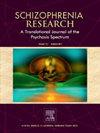老年慢性精神分裂症患者海马中RB1CC1-ATG16L1异常表达与齿状回细胞改变相关的组织病理学证据:一项初步的死后研究。
IF 3.6
2区 医学
Q1 PSYCHIATRY
引用次数: 0
摘要
背景:最近的证据使自噬,特别是RB1CC1基因成为精神分裂症病因学相关的焦点。我们对这些遗传特征是否以及如何转化为细胞功能的理解仍然有限。材料和方法:对10名精神分裂症患者和18名无任何神经/精神障碍的患者进行尸检研究,年龄、性别、尸检间隔、pH值和BRAAK评分相匹配。采用福尔马林固定、石蜡包埋、6 μm左右海马前、中、后段切片,检测RB1CC1和ATG16L1蛋白的组织病理学差异和免疫组化表达。结果:精神分裂症患者齿状回(DG)颗粒细胞面积(p = 0.005)和圆度(p = 0.012)明显低于对照组。抗精神病药物与循环度降低相关(p = 0.007)。RB1CC1与ATG16L1免疫表达呈正相关(p)。结论:我们首次提供了精神分裂症患者脑DG形态学改变的组织病理学证据。我们认为这些变化表明DG发育停滞,这与rb1cc1 - atg16l1介导的CA1自噬起始减少有关。我们认为这是一个病理过程,而RB1CC1-ATG16L1在DG和CA4中的上调可能代表了一种代偿/恢复机制。抗精神病药物可能上调RB1CC1-ATG16L1自噬起始。需要更大规模的研究来验证这些发现并探索临床相关性。本文章由计算机程序翻译,如有差异,请以英文原文为准。
Histopathological evidence of cellular alterations in the dentate gyrus is associated with aberrant RB1CC1-ATG16L1 expression in the hippocampus among older adults with chronic schizophrenia: A pilot post-mortem study
Background
Recent evidence brings autophagy, and specifically the RB1CC1 gene into sharp focus as aetiologically relevant to Schizophrenia. Our understanding of whether and how these genetic signatures translate to cellular functions remains limited.
Material and methods
Post-mortem study of 10 individuals with Schizophrenia and 18 individuals without any neurological/psychiatric disorder, matched for age, sex, post-mortem-interval, pH and BRAAK score. Formalin-fixed, paraffin-embedded, 6 μm sections cut through segments of the anterior, middle and posterior left or right hippocampus were examined for histopathological differences and immunohistochemical expression of RB1CC1 and ATG16L1 proteins.
Results
Dentate gyrus (DG) granule cells area (p = 0.005) and circularity (p = 0.012) were significantly lower among Schizophrenia vs. controls. Antipsychotics were associated with lower circularity (p = 0.007). RB1CC1 and ATG16L1 immunoexpression were positively correlated (p < 0.001) and significantly lower in the CA1 (p = 0.047, p = 0.005, respectively). RB1CC1 immunoexpression was significantly higher in the DG among Schizophrenia vs. controls (p = 0.047,). The latter was more pronounced among donors treated with antipsychotics. Lower ATG16L1 CA1 immunoreactivity was correlated with lower granule cell area (p < 0.001).
Conclusions
For the first time, we present histopathological evidence of morphological alterations in the DG of the human brain in Schizophrenia. We propose that these changes indicate DG developmental arrest, which is associated with diminished RB1CC1-ATG16L1-mediated autophagy initiation in the CA1. We suggest that this is a pathological process, whereas RB1CC1-ATG16L1 upregulation in the DG, and possibly in the CA4, may represent a compensatory/restorative mechanism. Antipsychotics may upregulate RB1CC1-ATG16L1 autophagy initiation. Larger studies are required to validate these findings and explore clinical correlations.
求助全文
通过发布文献求助,成功后即可免费获取论文全文。
去求助
来源期刊

Schizophrenia Research
医学-精神病学
CiteScore
7.50
自引率
8.90%
发文量
429
审稿时长
10.2 weeks
期刊介绍:
As official journal of the Schizophrenia International Research Society (SIRS) Schizophrenia Research is THE journal of choice for international researchers and clinicians to share their work with the global schizophrenia research community. More than 6000 institutes have online or print (or both) access to this journal - the largest specialist journal in the field, with the largest readership!
Schizophrenia Research''s time to first decision is as fast as 6 weeks and its publishing speed is as fast as 4 weeks until online publication (corrected proof/Article in Press) after acceptance and 14 weeks from acceptance until publication in a printed issue.
The journal publishes novel papers that really contribute to understanding the biology and treatment of schizophrenic disorders; Schizophrenia Research brings together biological, clinical and psychological research in order to stimulate the synthesis of findings from all disciplines involved in improving patient outcomes in schizophrenia.
 求助内容:
求助内容: 应助结果提醒方式:
应助结果提醒方式:


